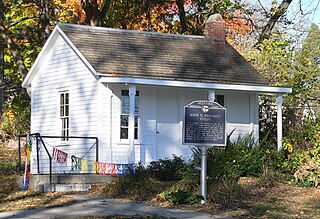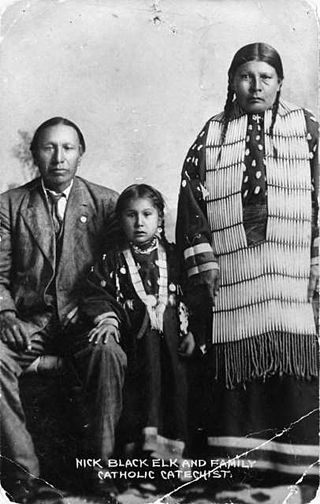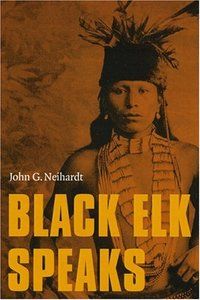
The Sioux or Oceti Sakowin are groups of Native American tribes and First Nations people from the Great Plains of North America. The Sioux have two major linguistic divisions: the Dakota and Lakota peoples. Collectively, they are the Očhéthi Šakówiŋ, or "Seven Council Fires". The term "Sioux", an exonym from a French transcription ("Nadouessioux") of the Ojibwe term "Nadowessi", can refer to any ethnic group within the Great Sioux Nation or to any of the nation's many language dialects.

Bancroft is a village in Cuming County, Nebraska, United States. The population was 496 as of the 2020 census.

The Wounded Knee Massacre, also known as the Battle of Wounded Knee was a massacre of nearly three hundred Lakota people by soldiers of the United States Army. The massacre, part of what the U.S. military called the Pine Ridge Campaign, occurred on December 29, 1890, near Wounded Knee Creek on the Lakota Pine Ridge Indian Reservation in South Dakota, following a botched attempt to disarm the Lakota camp. The previous day, a detachment of the U.S. 7th Cavalry Regiment commanded by Major Samuel M. Whitside approached Spotted Elk's band of Miniconjou Lakota and 38 Hunkpapa Lakota near Porcupine Butte and escorted them five miles westward to Wounded Knee Creek, where they made camp. The remainder of the 7th Cavalry Regiment, led by Colonel James W. Forsyth, arrived and surrounded the encampment. The regiment was supported by a battery of four Hotchkiss mountain guns. The Army was catering to the anxiety of settlers who called the conflict the Messiah War and were worried the Ghost Dance signified a potentially dangerous Sioux resurgence. Historian Jeffrey Ostler wrote in 2004, "Wounded Knee was not made up of a series of discrete unconnected events. Instead, from the disarming to the burial of the dead, it consisted of a series of acts held together by an underlying logic of racist domination."

Heȟáka Sápa, commonly known as Black Elk, was a wičháša wakȟáŋ and heyoka of the Oglala Lakota people. He was a second cousin of the war leader Crazy Horse and fought with him in the Battle of Little Bighorn. He survived the Wounded Knee Massacre in 1890. He toured and performed in Europe as part of Buffalo Bill's Wild West.
John Gneisenau Neihardt was an American writer and poet, amateur historian and ethnographer. Born at the end of the American settlement of the Plains, he became interested in the lives of those who had been a part of the European-American migration, as well as the Indigenous peoples whom they had displaced.

Black Elk Peak, formerly known as Harney Peak, is the highest natural point in the U.S. state of South Dakota and the Midwestern United States. It lies in the Black Elk Wilderness area, in southern Pennington County, in the Black Hills National Forest. The peak lies 3.7 mi (6.0 km) west-southwest of Mount Rushmore. At 7,244 feet (2,208 m), it is the highest summit in the United States east of the Rocky Mountains. Though part of the North American Cordillera, it is generally considered to be geologically separate from the Rocky Mountains.

Crazy Horse was a Lakota war leader of the Oglala band in the 19th century. He took up arms against the United States federal government to fight against encroachment by White American settlers on Native American territory and to preserve the traditional way of life of the Lakota people. His participation in several famous battles of the Black Hills War on the northern Great Plains, among them the Fetterman Fight in 1866, in which he acted as a decoy, and the Battle of the Little Bighorn in 1876, in which he led a war party to victory, earned him great respect from both his enemies and his own people.

Black Elk Speaks is a 1932 book by John G. Neihardt, an American poet and writer, who relates the story of Black Elk, an Oglala Lakota medicine man. Black Elk spoke in Lakota and Black Elk's son, Ben Black Elk, who was present during the talks, translated his father's words into English. Neihardt made notes during these talks which he later used as the basis for his book.

The heyoka is a kind of sacred clown in the culture of the Sioux of the Great Plains of North America. The heyoka is a contrarian, jester, and satirist, who speaks, moves and reacts in an opposite fashion to the people around them. Only those having visions of the thunder beings of the west, the Wakíŋyaŋ, and who are recognized as such by the community, can take on the ceremonial role of the heyoka.
Sitting Bull Crystal Caverns was a limestone cave complex nine miles south of Rapid City, South Dakota on the way to Mount Rushmore and by the Wind Cave National Park. From 1934 to 2015, the cave was open for the public to tour daily from Memorial Day weekend to Labor Day weekend.
Hilda Neihardt (1916–2004) was one of her father John G. Neihardt's "comrades in adventure," and at the age of 15 accompanied him as "official observer" to meetings with Black Elk, the Lakota holy man whose life stories were the basis for her father's book, Black Elk Speaks and for her own later works.
Raymond J. DeMallie was an American anthropologist whose work focuses on the cultural history of the peoples of the Northern Plains, particularly the Lakota. His work is informed by interrelated archival, museum-based, and ethnographic research in a manner characteristic of the ethnohistorical method. In 1985 he founded and became the director of the American Indian Studies Research Institute at Indiana University Bloomington, alongside Douglas Parks, whom he worked collaboratively throughout majority of his career to preserve and translate various Indigenous languages, after having first met in 1980. Shortly after Parks started to work with DeMallie at Indiana University Bloomington. They got married in 2016.
Joseph Epes Brown was an American scholar whose lifelong dedication to Native American traditions helped to bring the study of American Indian religious traditions into higher education. His seminal work was a book entitled, The Sacred Pipe, an account of his discussions with the Lakota holy man, Black Elk, regarding the religious rites of his people.

A Ballad of the West is a three-part story by Bobby Bridger told in Homeric verse and song about the Mountain Men, William F. "Buffalo Bill" Cody, and the Lakota Sioux people inspired by John G. Neihardt's A Cycle of the West.
Sharpsburg is an unincorporated community in Christian County, Illinois, United States. It is the birthplace of Native American scholar John Neihardt, author of Black Elk Speaks and many other works.
The red road is a modern English-language concept of the right path of life, as inspired by some of the beliefs found in a variety of Native American spiritual teachings. The term is used primarily in the Pan-Indian and New Age communities, and rarely among traditional Indigenous people, who have terms in their own languages for their spiritual ways. Native Americans' spiritual teachings are diverse. With over 500 federally-recognized tribes in just the US, while some regional practices and beliefs might be similar, the cultures are highly individualized. Individual ceremonies and particular beliefs tend to be unique to the people of these diverse bands, tribes and nations.

The John G. Neihardt State Historic Site, also known as the Neihardt Center, is located in Bancroft, Nebraska, United States and features museum exhibits about Nebraska Poet Laureate John Neihardt.
The Divine Enchantment is John Neihardt's earliest narrative poem, first published in 1900. The poem is divided into ten cantos, and uses a variety of rhyming styles.
Wocekiye is a Lakota language term meaning "to call on for aid," "to pray," and "to claim relationship with". It refers to a practice among Lakota people engaged in both the traditional Lakota religion as well as forms of Christianity.
The Poet Laureate of Nebraska is the poet laureate for the U.S. state of Nebraska.









